This Gluten-Free Sandwich Bread Recipe makes a soft, tender and healthy loaf that’s perfect for sandwiches, toast and more!
This post includes tips and tricks to make an amazing gluten-free sandwich bread with delicious flavor and texture every time. It’s sure to become your go-to recipe!
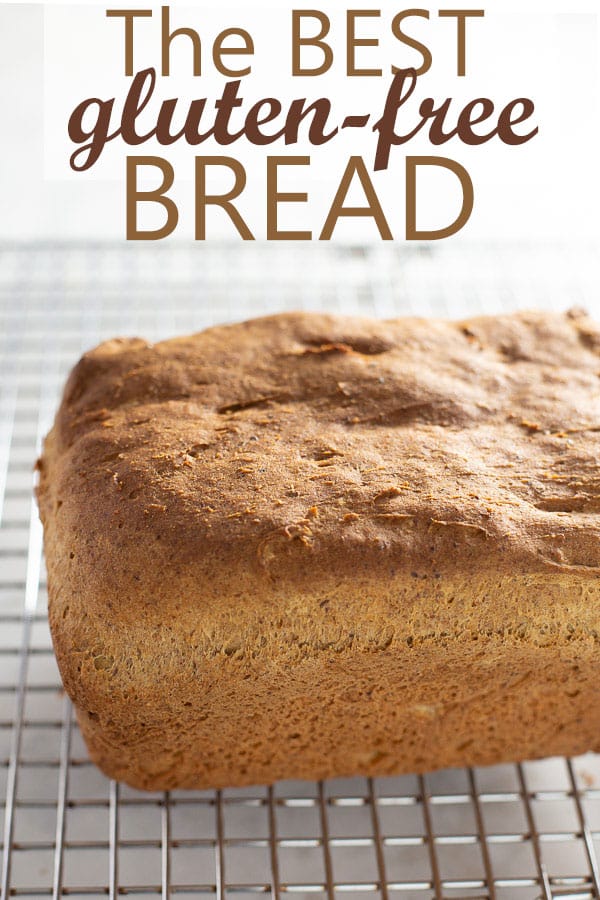
I have tried a lot of homemade gluten free bread recipes over the years. I can confidently say this is the best gluten-free homemade sandwich bread I’ve ever made or eaten!
It has the perfect texture (not crumbly at all!), delicious flavor (think flaxseed with a touch of honey), and is way more nutritious than store-bought bread (thank you almond flour and psyllium husk powder).
Best of all this bread tastes amazing NOT toasted!
So many gluten-free breads have to be toasted to be edible. This bread is not only delicious without toasting the first day, but also good for 2 days after it’s baked. You’ll never need to try another recipe for gluten free sandwich bread!
Table of Contents
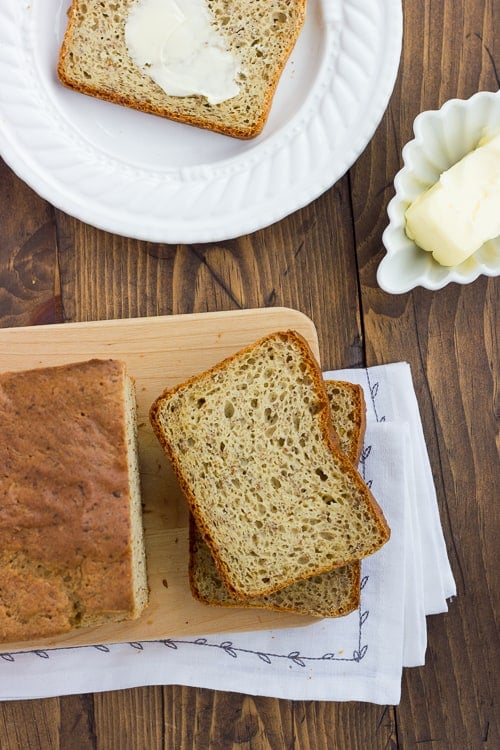
What Is Gluten-Free Sandwich Bread Made Out Of?
Just like regular bread is made with wheat flour, gluten-free bread is made with flours from gluten-free grains like rice, sorghum, etc.
In this easy gluten-free bread recipe, I use a gluten-free all-purpose flour. Gluten-free all-purpose flour is simply a blend of gluten-free flours and starches that’s designed to mimic the results of wheat flour in baking.
I’ve found gluten-free baking isn’t always as simple as swapping in gluten-free flour for wheat flour. This is especially the case for gluten-free yeasted breads!
Why You’ll Love this Recipe!
- Perfect texture (Not crumbly!)
- Delicious flaxseed and honey flavor
- Easy to make
- Doesn’t need to be toasted
- Lasts up to three days
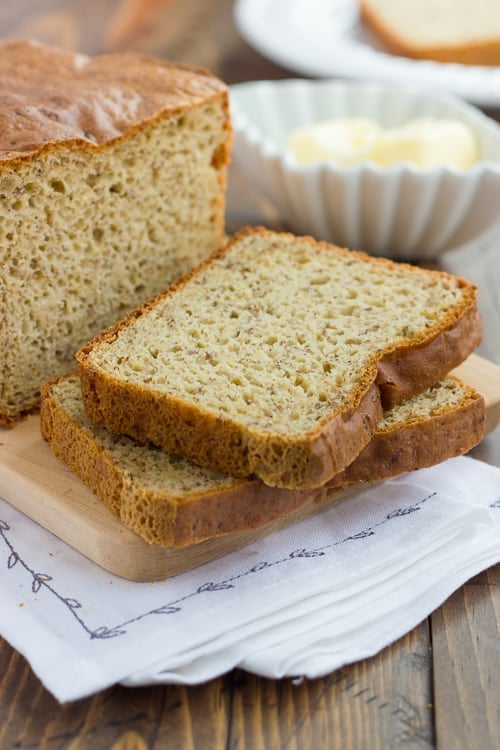
For more gluten free recipes and gluten-free bread dough, be sure to check out these Gluten-Free Dinner Rolls or this Gluten-Free Flatbread.
How to Make Gluten-Free Sandwich Bread
These how-to numbered pictures match up with the instructions below. I’ve also included a video with step-by-step instructions for making this gluten-free sandwich bread.
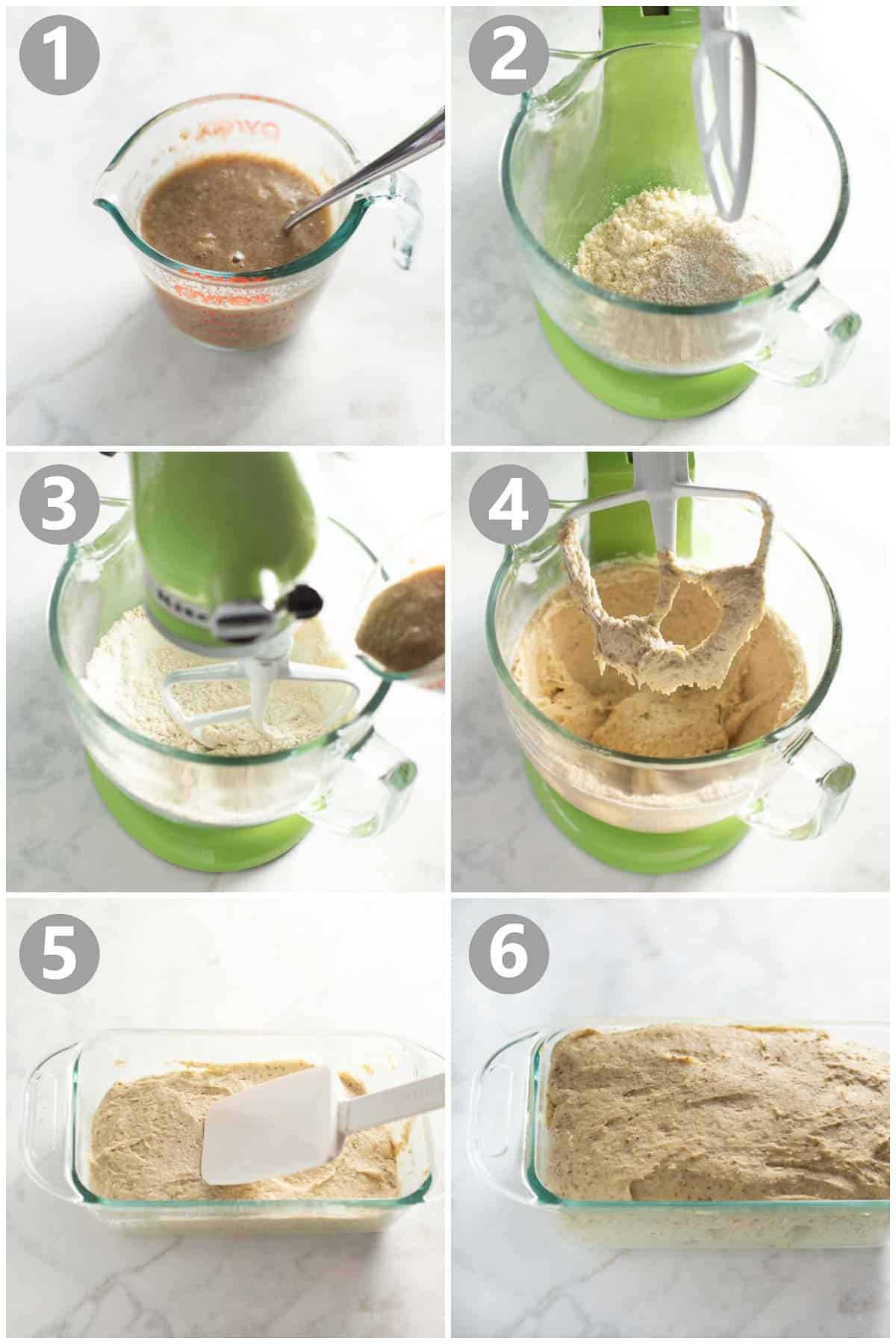
- Mix together the warm water, flaxseed meal, and psyllium husk. Let the wet ingredients sit for 2-3 minutes before adding it to the dough.
- Combine all the dry ingredients in the large bowl of a stand mixer. Mix to combine.
- Add the psyllium husk mixture along with the eggs, butter and honey to the gluten-free flour blend and other dry ingredients.
- Beat the dough for 6 minutes.
- Use a rubber spatula to smooth the dough into a prepared pan. Let rise in a warm place for 45-60 minutes. (You can cover it with plastic wrap, if desired. But make sure to spray the plastic wrap with cooking spray, first!)
- Once you let the dough rise, bake for 35-45 minutes.
You also might like this gluten-free crescent roll recipe.
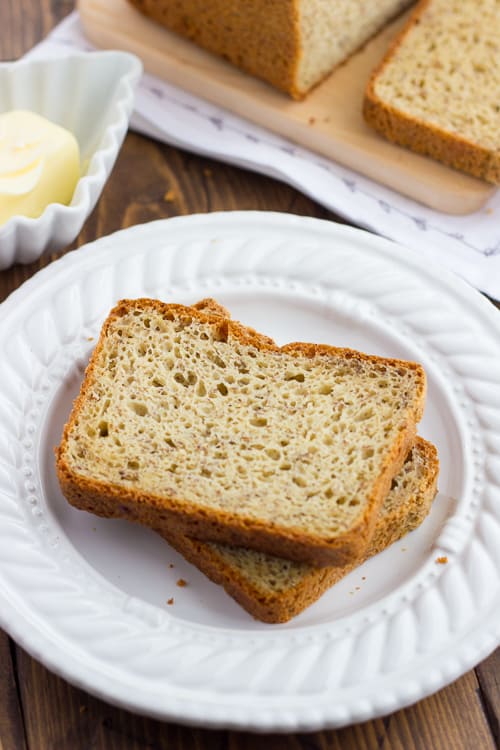
Storage Instructions
Be sure to let this bread cool fully on a cooling rack before storing in an airtight container, plastic bread bag, or plastic wrap. Store at room temperature or in the fridge. This gluten-free sandwich bread tastes great up to two days after making.
Gluten-Free Sandwich Bread FAQs
I recommend using a high-quality, gluten-free all-purpose flour for gluten-free baking. For best results, pick a blend that contains xanthan gum or another binder. These blends are usually called measure-for-measure or 1:1 baking flour. This is my favorite gluten-free measure-for-measure baking flour.
Yes! You can easily make this bread dairy-free by substituting the butter for olive oil. However, you cannot omit the eggs. Eggs are important for the structure and flavor of this loaf.
Be sure to carefully measure the dry ingredients so you get the right amounts. Bake the bread in a glass loaf pan. This helps it rise and brown properly. Let the bread rise for the right amount of time. If the bread rises for too long it may sink slightly in the middle once it’s baked.
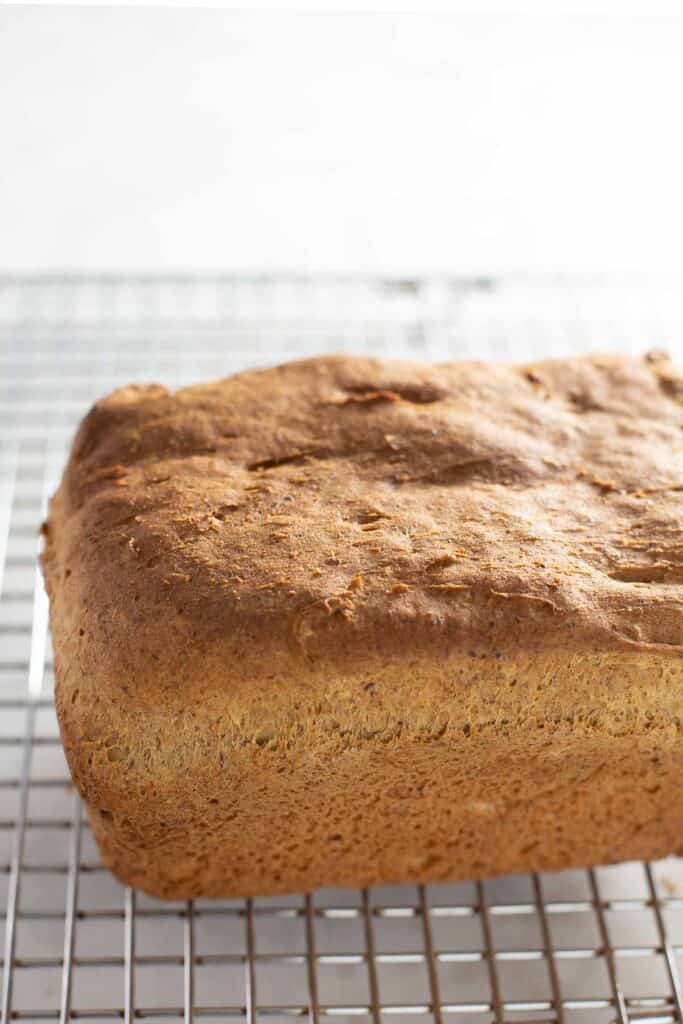
Gluten-Free Bread Tips and Tricks
Gluten-free bread recipes are very different than regular bread recipes. Here are a few things to keep in mind while making gluten-free sandwich bread:
- Gluten-free bread only needs a single rise. I use instant yeast or fast-acting active dry yeast in this gluten-free bread recipe because the dough only needs to rise one time. Gluten-free dough isn’t stable enough for a double rise. The good news is this makes this delicious gluten free bread much faster to make than traditional bread.
- You’ll need to add some binders. In traditional bread recipes gluten is what gives the bread structure and stability. Since this bread is obviously missing the gluten, it benefits from other ingredients that act as binders. I use a combination of psyllium husk powder, ground flaxseed and a flour blend that contains xanthan gum in this gluten-free bread recipe to give the bread structure and stability.
- The dough will resemble cookie dough. Don’t be alarmed when this bread dough looks nothing like regular bread dough! It’s supposed to be that way. Just like this gluten-free pizza crust recipe, the dough will be thick and sticky, but not kneadable. See the picture below (Step 4) for a visual on the consistency. You can also see the video in this post to see what the final dough for this gluten free sandwich bread recipe looks like.
Looking for more gluten-free bread recipes? Try my gluten-free breadsticks.
More Gluten-Free Recipes
If you like this gluten free sandwich bread recipe, leave me a comment below. I’d love to hear from you!
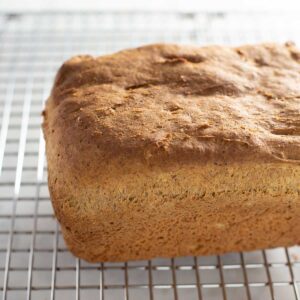
Gluten-Free Sandwich Bread (Amazing & Easy!)
Video
Ingredients
Dry Ingredients:
- 1 3/4 cups gluten-free 1:1 baking flour 280 grams
- 1 envelope highly active or instant yeast 2 1/4 teaspoons
- 1/2 cup almond flour 40 grams
- 1 teaspoon fine salt
Psyllium Husk Mixture:
- 1 cup warm water
- 1/4 cup ground flaxseed meal 30 grams
- 2 teaspoons psyllium husk powder
Wet Ingredients:
- 3 eggs
- 2 tablespoons honey
- 1/4 cup butter or olive oil
Instructions
- In the bowl of a stand mixer, add the dry ingredients and mix to combine.
- In measuring cup, combine the warm water, flaxseed and psyllium husk powder. Whisk until smooth and let sit for 1-2 minutes before adding to the dry ingredients.
- With the mixer running on low, add the psyllium husk mixture along with the eggs, honey and butter. Increase the speed to medium-high speed and beat for 6 minutes.
- Scoop the batter and smooth into a grease 9×5 pan. Let rise in a warm spot for 45-60 minutes. The bread will not double in size but should rise a few inches.
- Preheat the oven to 350F.
- Bake the bread for 35-45 minutes, until the internal temperature registers 200F on an instant-read thermometer or until the top is golden and seems firm when tapped.
- Let the bread cool in the pan for 10 minutes. Turn out onto a wire rack to cool for at least another 20 minutes before slicing. Enjoy!
Notes
- I recommend using a high, quality gluten-free all-purpose flour for gluten-free baking. For best results, pick a blend that contains xanthan gum or another binder.
- Be sure to carefully measure the dry ingredients so you get the right amounts.
- Bake the bread in a glass loaf pan. This helps it rise and brown properly.
- Let the bread rise for the right amount of time. If the bread rises for too long it may sink slightly in the middle once it’s baked.
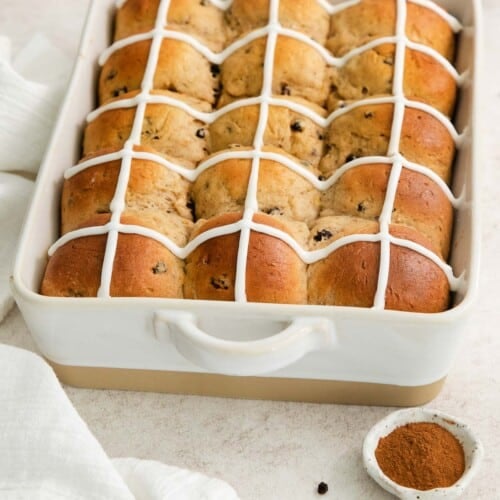
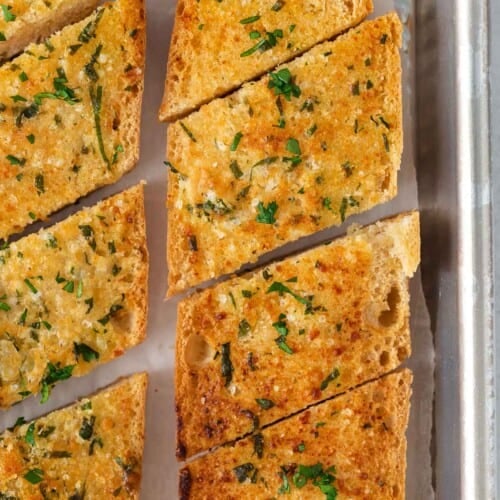
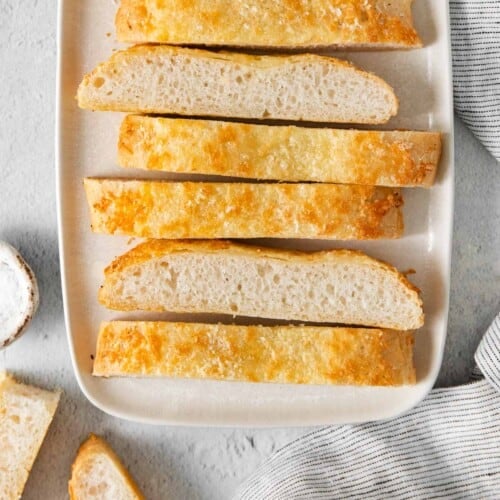
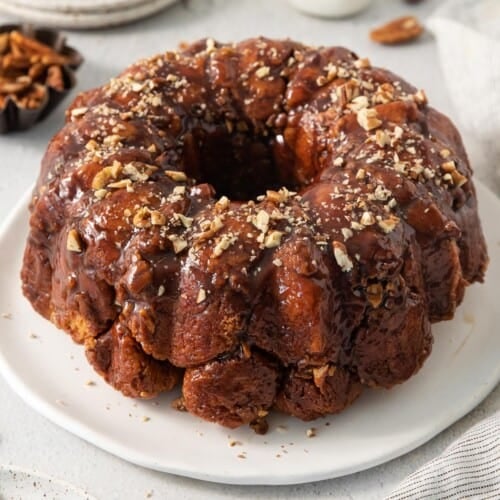
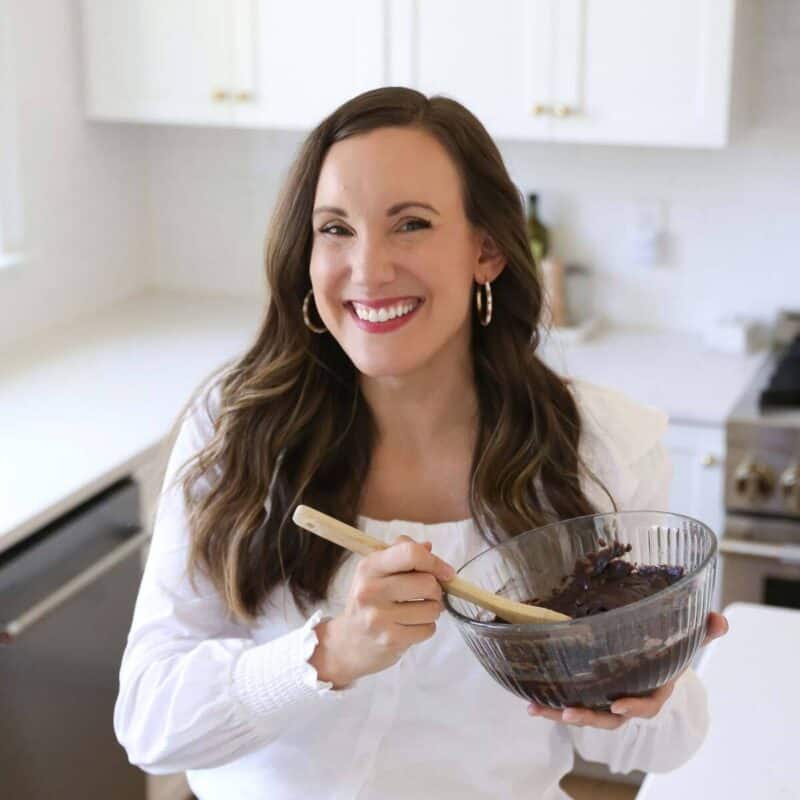
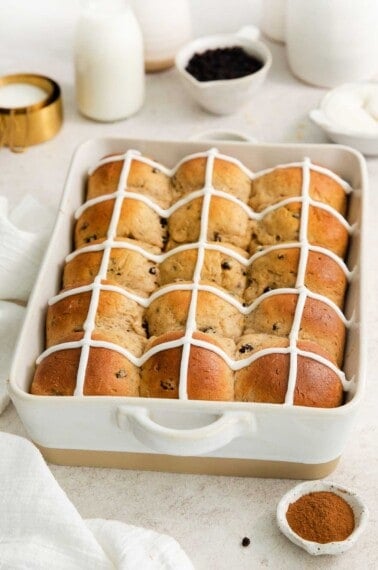
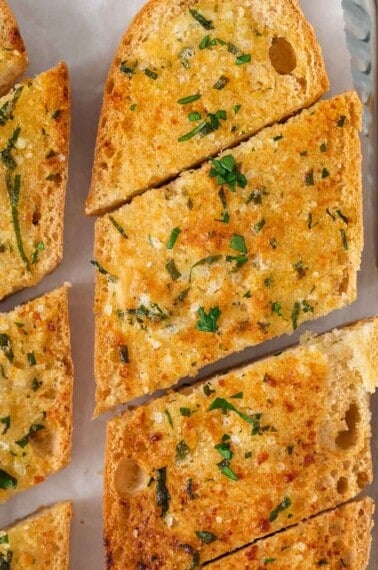
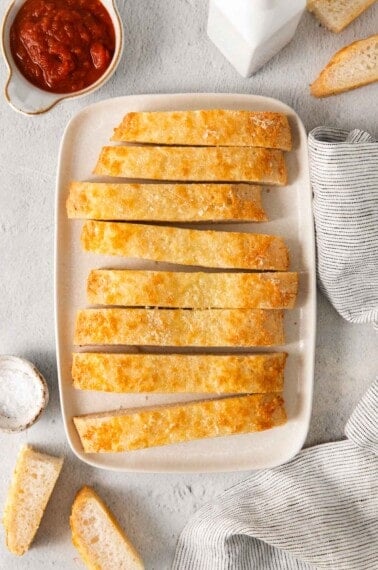
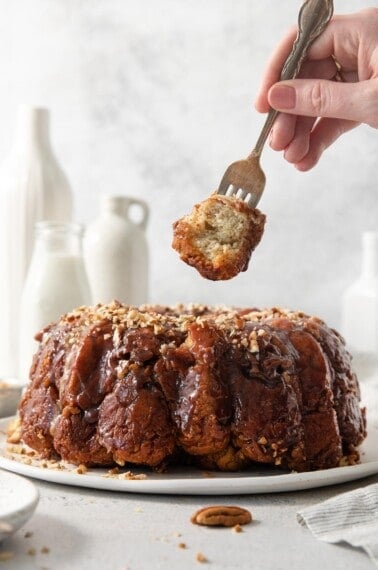










How do you store this bread and how long is it good for? Can it be frozen?
Question: Your recipe uses a gluten free flour that says on the package, “for standard all-purpose or whole wheat flour in non-yeasted recipes.” But in your recipe you use yeast with King Arthur Gluten Free 1:1 Substitute Measure for Measure Flour. So this still works with your gluten free bread recipe?
This is such a great recipe. I substituted corn meal for the flax as my celiac doesn’t like flax and it worked perfect. Actually doubled the recipe and have two loafs.
This is our favorite gluten free bread recipe. I also love that it is so easy to make.
First time having success with a gf bread! I’m so happy. And my husband’s glad I’m done experimenting with all the expensive gf ingredients.
Can you tell me how to best store it? And about how long does it last (if we make it that long)? Thanks so much for sharing this recipe! We’re so grateful to have a delicious, healthy, CHEAPER, easy to make bread option.
Im so thankful this recipe is here. I’ve been gluten free my whole life and haven’t found a good gluten free bread recipe that worked. I LOVE that this recipe doesn’t require a specific kind of flour, just a good all-purpose blend.
I used my own blend and didn’t have mixer, here’s how I learned I need to adjust the recipe: instead of mixing all the wet at once with the dry and psyllium mixture I add one wet ingredient and mix by hand until smooth, only then could I add the next wet ingredient.
I made this recipe twice with success, just the first time I spent like an hour with my hands blending out the clumps because I mixed it all at once!
Bread tastes amazing and has a great texture, not dry or crumbly
Hi! I am wondering if you have tried a gf bread recipe not using any flour but using potato starch and tapioca starch instead? I’ve been trying to duplicate a recipe of a bread that I can longer get anywhere! And it’s absolutely perfect!
I don’t have a bread recipe that only uses those ingredients. Sorry about that!
Any chance this could be made without the almond flour? My daughter has a tree nut allergy.
Yes! You can easily use more gluten-free 1:1 baking flour in place of the almond flour.
I’m so glad to have found this recipe (as well as others on your site), this bread is delicious! Thank you so much! Question – do you use your own flour blend for this recipe? I just used the Compliments brand (from Sobeys in Canada) and weighed it instead of using a measuring cup, and it turned out great!
Hooray! I’m so glad you like the bread. I usually use a store-bought blend when I make this bread. I think it would work great with my blend though!
I want to thank you for this amazing recipe. I didn’t think I could eat bread this good anymore after developing gluten intolerance. I’ve made two loaves and followed your recipe exactly and the bread was so good that I ate some delicious slices plain right out of the pan. I appreciate so much that this bread has the nutritional boost of almond flour, psyllium powder, and flaxseed meal that the gluten-free loaves at the grocery store near me don’t have. I slightly bumped up the almond flour (just 20g more) and reduced the gluten free flour blend (King Arthur Measure by Measure) by the same amount and still got great results. I also slightly increased the ground flaxseed meal too and all was well. Thank you again for developing this excellent gluten-free recipe. Recipes like this make me so much more hopeful that having gluten intolerance does not have to mean giving up everything you love to eat!
I’m so happy you like the sandwich bread! Great to know you got good results with those modifications. Thanks for the comment!
I am trying this for the first time today. I had high hopes until I realized I used 1/2 cup butter instead of 1/4 cup. Oy! This ought to be interesting.
Can I use your flour blend in this recipe? Would I need to add xanthan gum? Thanks, can’t wait to try this!
Yes I think that should work great! You don’t need to add any xanthan gum because my blend has buckwheat flour that has elastic properties.
This is my daughters most favorite gluten free bread. Thank you so much for the recipe! I’ve tried many others that just seem to fall apart in a sandwich so we are so happy to now have a good recipe that holds together.
We slice it and store in the freezer to make for easy and quick lunches. Just toast the bread or microwave to thaw.
Hooray! I’m so glad your daughter likes it. Great idea to slice and freeze it!
Can you cook this in a bread machine
I don’t know! I need to create a recipe specifically for the bread machine – sorry about that.